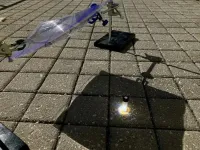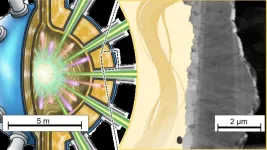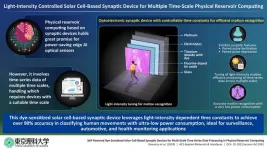(Press-News.org) A team from the Champalimaud Foundation (CF) has pinpointed a critical neural circuit for sexual rejection, identifying a set of brain cells that play a crucial role in determining whether a female accepts or rejects mating attempts based on her reproductive cycle. Their findings, published today in Neuron, deepen our understanding of how the brain regulates social and reproductive behaviours.
Female mammals, such as rodents, accept mating attempts only during their fertile phase, and actively reject males outside this period. While the brain areas controlling sexual receptivity are well-studied, the mechanisms behind active rejection are less so.
“Sexual rejection isn’t just the absence of receptivity, it’s an active behaviour”, explains Susana Lima, senior author and head of the Neuroethology Lab at CF. “Females exhibit defensive actions like running away, kicking, or boxing the male. We wanted to understand how the brain switches between these two drastically different behavioural states”.
Central to their research is the ventromedial hypothalamus (VMH), an evolutionarily ancient brain region that controls social and sexual behaviour across species, including humans. “We suspected that the VMH might house a separate population of cells dedicated to rejection, based on previous low-resolution imaging experiments showing VMH activity during both acceptance and rejection of male advances”, says Lima.
The team focused on the anterior VMH, a less-explored area, particularly on cells responsive to the hormone progesterone, which fluctuates throughout the reproductive cycle. “These neurons are ideal for studying how the female brain toggles between acceptance and rejection during the cycle”, notes first author Nicolas Gutierrez-Castellanos.
No. Yes. It Depends.
“Understanding this flip gives us insight into how the brain integrates signals from the environment and the body to shape behaviour”, continues Gutierrez-Castellanos. “It’s a striking example of how the same stimulus—in this case, an eager male—can elicit completely opposite behaviours, depending on the female’s internal state”.
Through advanced techniques like fibre photometry—which tracks real-time brain activity by measuring calcium signals—researchers observed the behaviour of these progesterone-sensitive neurons in both receptive and non-receptive female mice during interactions with males. The results were striking: anterior VMH neurons became highly active in non-receptive females, correlating with defensive actions like kicking and boxing, but were far less active in receptive females.
“It appears that progesterone-responsive neurons in the anterior VMH act as gatekeepers for sexual rejection”, says co-first author Basma Husain. “When a female is outside her fertile window, these neurons become highly active, prompting rejection. But during fertility, their activity decreases, allowing mating to occur”.
The Brain’s Dual Control Knobs
How do these neurons switch on or off depending on fertility? To investigate, the team performed electrophysiology experiments, measuring the activity of progesterone-responsive neurons in brain slices. “We found that in non-receptive females, these neurons received more excitatory signals, making them more likely to be activated”, explains Gutierrez-Castellanos. “In receptive females, they received more inhibitory signals, reducing their likelihood of firing. It’s a testament to how adaptable and flexible neural connections in the hypothalamus—and the brain—can be”.
“The activity levels and excitation/inhibition balance of progesterone-responsive neurons in the anterior VMH strongly suggested their role in sexual rejection”, says Husain. “To confirm this, we used optogenetics to selectively activate these neurons with light”. Indeed, artificially stimulating them during the fertile phase induced rejection behaviours such as kicking and boxing. “It’s like flipping a switch—even though the females were fertile, they acted as if they weren’t”.
Conversely, silencing these neurons with a chemical drug in non-receptive females reduced rejection behaviours, though interestingly, it didn’t make them fully receptive—indicating that two distinct populations of neurons, one controlling rejection and the other receptivity, work in concert to produce the appropriate behaviour according to the female’s internal state.
“This setup gives the brain two ‘knobs’ to adjust”, Lima explains. “It’s a more efficient and robust way for the brain to balance these behaviours, ensuring mating occurs when conception is most likely, while minimising the risks and costs of mating, such as exposure to predators or diseases”.
Husain adds, “This dual-system likely adds flexibility to the brain’s regulation of sexual behaviour. Sex isn’t deterministic. Even during the receptive phase, a female might still reject males, so the ability to draw on both sets of neurons may allow for more nuanced and dynamic behaviours”.
Notably, these findings align with recent research showing that progesterone-responsive neurons in the posterior VMH, which drive sexual receptivity, undergo similar cycle-dependent changes, but in the opposite direction—active during the fertile phase and inactive outside it.
“The VMH exists in humans and likely plays similar roles”, notes Lima. “Recent studies in mouse models have shown that the VMH changes in pathological conditions like polycystic ovarian syndrome. Additionally, socially isolating female mice during development may lead to reduced sexual receptivity, with alterations in the same brain area, underscoring the VMH’s clinical relevance”.
“We’re just beginning to scratch the surface of how the brain’s internal wiring orchestrates social behaviour”, concludes Lima. “There’s much more to learn, but these findings bring us a step closer to understanding how neural mechanisms and internal states drive complex social interactions, from sexual behaviour to aggression and beyond”.
END
Key brain circuit for female sexual rejection uncovered
2024-11-25
ELSE PRESS RELEASES FROM THIS DATE:
Electrical nerve stimulation eases long COVID pain and fatigue
2024-11-25
A wearable electrical nerve stimulation device can provide relief to people experiencing the persistent pain and fatigue linked to long COVID, a study co-led by UCLA and Baylor College of Medicine researchers suggests.
Long-COVID, a complex and lingering condition following COVID-19 recovery, affects approximately 1 in 13 adults in the U.S. Symptoms such as widespread pain, fatigue, and muscle weakness often continue to disrupt daily activities, including walking and basic tasks.
The study, published in the peer-reviewed Nature Scientific Reports, focused on a wearable Transcutaneous Electrical Nerve Stimulation ...
ASTRO issues update to clinical guideline on radiation therapy for rectal cancer
2024-11-25
ARLINGTON, Va., November 25, 2024 — The American Society for Radiation Oncology (ASTRO) issued today an updated clinical guideline for physicians who use radiation therapy to treat patients with locally advanced rectal cancer. This update incorporates new data on patient selection and best practices from several practice-changing clinical trials published since the prior guideline was issued in 2020. The updated ASTRO guideline is published in Practical Radiation Oncology.
Colorectal cancer is the leading cause of cancer deaths for Americans aged 20 to 49 and the second most common cause of cancer-related death overall. In the U.S., the incidence of early ...
Mount Sinai opens the Hamilton and Amabel James Center for Artificial Intelligence and Human Health to transform health care by spearheading the AI revolution
2024-11-25
See accompanying video here: https://youtu.be/o-opCV6oe3o
New York, NY [November 25, 2024]—Today, the Mount Sinai Health System, one of New York City’s largest academic medical systems, announced the opening of the Hamilton and Amabel James Center for Artificial Intelligence and Human Health, which is dedicated to enhancing health care delivery through the research, development, and application of innovative artificial intelligence (AI) tools and technologies.
The state-of-the-art research center solidifies ...
Researchers develop tools to examine neighborhood economic effects on spinal cord injury outcomes
2024-11-25
East Hanover, NJ – November 25, 2024 – Kessler Foundation researchers have developed robust measures of neighborhood economic factors to study how social determinants influence health outcomes after spinal cord injury (SCI). The study reveals that individuals in disadvantaged neighborhoods face higher risks of poor health, emphasizing the need for public policy to address environmental inequities.
Research scientists developed and validated two composite measures – neighborhood socioeconomic ...
Case Western Reserve University awarded $1.5 million to study vaginal bacterial linked to serious health risks
2024-11-25
CLEVELAND—Bacterial vaginosis (BV), the most prevalent condition affecting the female reproductive system in women aged 15 to 44, is linked to such serious health risks as preterm birth, gynecological malignancies and sexually transmitted diseases.
But effective long-term treatments for BV are limited: More than half experience a recurrence within six months, according to several studies.
With a $1.5 million grant from the National Institutes of Health (NIH), researchers at the Case Western Reserve School of Medicine will study the dynamics of BV in hopes of identifying a more effective approach.
“We hope to gain insights into promoting ...
The next evolution of AI begins with ours
2024-11-25
In a sense, each of us begins life ready for action. Many animals perform amazing feats soon after they’re born. Spiders spin webs. Whales swim. But where do these innate abilities come from? Obviously, the brain plays a key role as it contains the trillions of neural connections needed to control complex behaviors. However, the genome has space for only a small fraction of that information. This paradox has stumped scientists for decades. Now, Cold Spring Harbor Laboratory (CSHL) Professors Anthony Zador and Alexei Koulakov have devised a potential solution using artificial intelligence.
When Zador first encounters this problem, he puts a ...
Using sunlight to recycle black plastics
2024-11-25
Not all plastics are equal — some types and colors are easier to recycle than others. For instance, black foam and black coffee lids, which are often made of polystyrene, usually end up in landfills because color additives lead to ineffective sorting. Now, researchers report in ACS Central Science the ability to leverage one additive in black plastics, with the help of sunlight or white LEDs, to convert black and colored polystyrene waste into reusable starting materials.
“Simple, visible light irradiation holds the potential to ...
ODS FeCrAl alloys endure liquid metal flow at 600 °C resembling a fusion blanket environment
2024-11-25
Researchers explored protective coatings on advanced to resist corrosion in fusion reactors. They tested α-Al2O3 oxide layers on ODS alloys in a high-temperature, flowing lithium-lead environment. Even bare ODS alloys formed a durable γ-LiAlO2 layer in situ, which suppressed further corrosion. The layers exhibited strong adhesion under mechanical stress, making these findings crucial for improving material durability in fusion reactors and high-temperature energy systems.
Fusion reactors, a promising source of sustainable energy, require advanced materials that can withstand extreme temperatures and corrosive environments ...
A genetic key to understanding mitochondrial DNA depletion syndrome
2024-11-25
Mitochondrial DNA depletion syndrome (MTDPS) is a rare genetic disorder characterized by a marked decrease in mitochondrial DNA (mtDNA). This condition can cause symptoms including muscle weakness, fatigue, and neurological issues, particularly affecting the liver and brain in cases of hepatocerebral MTDPS. Mitochondrial diseases, which represent some of the most common types of metabolic disorders, can result in the failure of multiple organ systems. Currently, over 400 genes linked to these diseases have been identified. Notably, many of these genes are associated with the mitochondrial contact site and cristae ...
The future of edge AI: Dye-sensitized solar cell-based synaptic device
2024-11-25
Artificial intelligence (AI) is becoming increasingly useful for the prediction of emergency events such as heart attacks, natural disasters, and pipeline failures. This requires state-of-the-art technologies that can rapidly process data. In this regard, reservoir computing, specially designed for time-series data processing with low power consumption, is a promising option. It can be implemented in various frameworks, among which physical reservoir computing (PRC) is the most popular. PRC with optoelectronic artificial synapses (junction structures that permit a nerve cell to transmit an electrical or chemical signal to another cell) that mimic human ...









